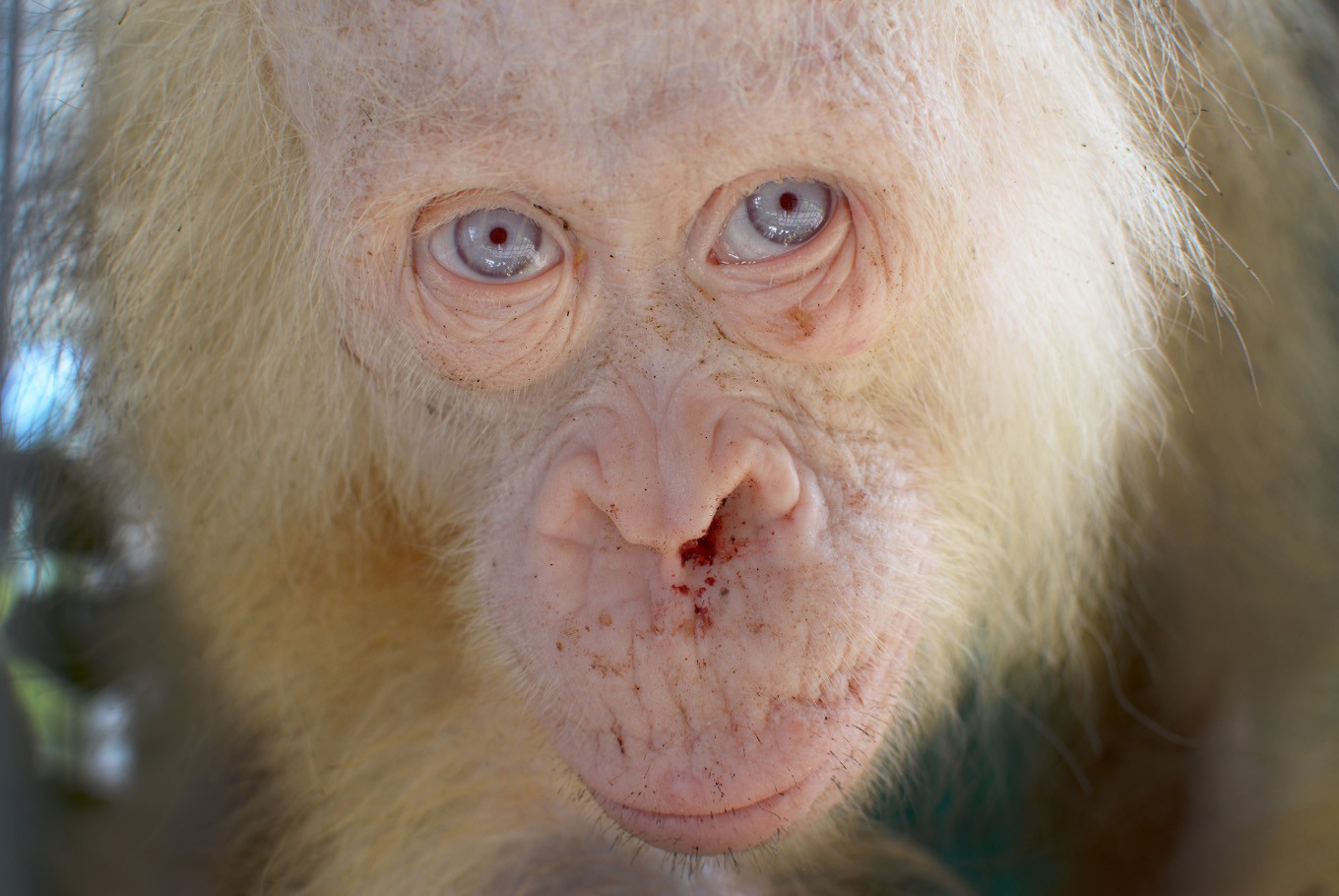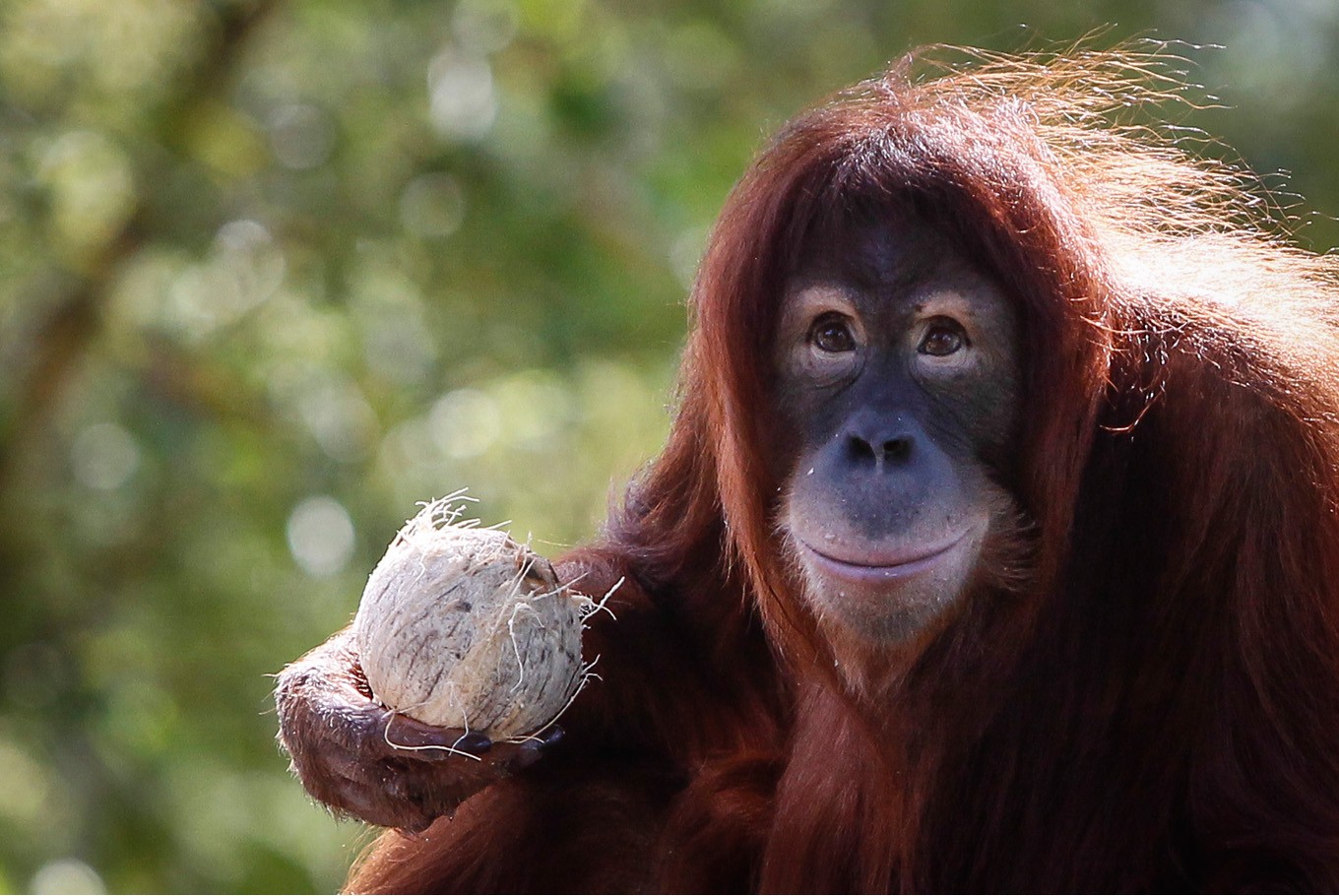Popular Reads
Top Results
Can't find what you're looking for?
View all search resultsPopular Reads
Top Results
Can't find what you're looking for?
View all search resultsDistinctive name sought for rare albino Indonesian orangutan
Change text size
Gift Premium Articles
to Anyone
 This handout picture taken on April 30, 2017 and released on May 2, 2017 by the Borneo Orangutan Survival Foundation shows a rare albino orangutan that was saved from villagers in Kapuas Hulu, on the Indonesian side of Borneo island. A rare albino orangutan has been saved from villagers on the Indonesian part of Borneo island who were keeping the white-haired, blue-eyed creature in a cage, a protection group said on May 2. The Borneo Orangutan Survival Foundation, which is caring for the critically endangered ape, said the organisation had never before in its 25-year history taken in an albino orangutan. (BORNEO ORANGUTAN SURVIVAL FOUNDATION / AFP /File)
This handout picture taken on April 30, 2017 and released on May 2, 2017 by the Borneo Orangutan Survival Foundation shows a rare albino orangutan that was saved from villagers in Kapuas Hulu, on the Indonesian side of Borneo island. A rare albino orangutan has been saved from villagers on the Indonesian part of Borneo island who were keeping the white-haired, blue-eyed creature in a cage, a protection group said on May 2. The Borneo Orangutan Survival Foundation, which is caring for the critically endangered ape, said the organisation had never before in its 25-year history taken in an albino orangutan. (BORNEO ORANGUTAN SURVIVAL FOUNDATION / AFP /File)
C
onservationists taking care of a recently discovered albino orangutan in Kalimantan are calling on the public to help give a “unique” name to this rare specimen of the native Indonesian ape in an effort to raise awareness for the protection of the endangered species.
“This little girl needs a name,“the Borneo Orangutan Survival Foundation (BOSF), a local conservation group in Central Kalimantan, said over its Twitter account @bornean_OU earlier this week, referring to the 5-year-old female albino orangutan.
People can suggest any name they want by replying to the tweet using the hashtag #albinoorangutan, or by sending their suggestions to name@orangutan.or.id. The BOSF will announce the chosen name on May 15. Besides calling for public participation, the group also uploaded a video of the blue-eyed orangutan with details of how people can help protect nature’s beauty.
The International Union for the Conservation of Nature (IUCN) has declared the species to be critically endangered, one category before extinction, since it estimated that there are about 100,000 Bornean orangutans left. The IUCN also estimated the figure will further decline to 47,000 by 2025.
The protected animals, which only live on Sumatra and in Kalimantan, the Indonesian part of Borneo Island, still face rampant illegal trading and have had their habitats diminished by industrial expansion in their forests, both of which have contributed to their decreasing population.
The BOSF had forecast there were a number of albino orangutans living in the wild on the country’s largest island after the discovery of the first of its kind in the region last week.
The BOSF took a white-haired female orangutan in late April from a farmer in Tenggirang village, Kapuas Regency, Central Kalimantan, who found the animal walking “infirmly” in a forest near the area.
BOSF CEO Jamartin Sihite said previously the NGO could confirm the 5-year-old orangutan was an animal with albinism after a test conducted by the group’s medical team had found “its eyes are very sensitive to lights” — one of the symptoms of the congenital disorder.
Jamartin said the female orangutan, which some workers have proposed to name Baputi (white in Dayaknese), was not an example of a “newly discovered species of Borneo orangutan,” telling the media the possibility was high there were still numerous albino orangutan surviving in the Kalimantan forest.
“At least there are her parents from whom the albino orangutan inherited the disorder, for it is a genetically transferred one,” Jamartin said.
(Read also: 6 more orangutans released into Kehje Sewen forests)
 In this Dec. 31, 2015, file photo, Tsunami, an eleven year old female Sumatran Orangutan eats fruit during her birthday celebration at the National Zoo Ape Center in Kuala Lumpur, Malaysia. Primates are heading toward an extinction crisis, a new international study warns. And it’s our fault that our closest biological relatives are in trouble, scientists said. About 60 percent of the more than 500 primate species, such as gorillas, monkeys and lemurs, are “now threatened with extinction” and three out of four primate species have shrinking populations, according to a study by 31 primate experts published in the Jan. 18, 2017, journal Science Advances.(AP Photo/Joshua Paul)
In this Dec. 31, 2015, file photo, Tsunami, an eleven year old female Sumatran Orangutan eats fruit during her birthday celebration at the National Zoo Ape Center in Kuala Lumpur, Malaysia. Primates are heading toward an extinction crisis, a new international study warns. And it’s our fault that our closest biological relatives are in trouble, scientists said. About 60 percent of the more than 500 primate species, such as gorillas, monkeys and lemurs, are “now threatened with extinction” and three out of four primate species have shrinking populations, according to a study by 31 primate experts published in the Jan. 18, 2017, journal Science Advances.(AP Photo/Joshua Paul)
He said there have been no reports of the presence of other albino orangutan since the group was established 25 years ago, but he was not sure whether this kind of orangutan could also be found on Sumatra.
No adequate scientific evidence exists to gauge how rare albino orangutan are compared to normal orangutan, so the number of albinos cannot be estimated.
Workers in the BOSF orangutan rehabilitation center in Nyaru Menteng, Central Kalimantan, a one-hour drive from the Palangkaraya site where the albino orangutan is currently being treated, have estimated they needed at least one month to properly take care of the animal before releasing it back into the wild.
BOSF officials interviewed by The Jakarta Post said the animal was in a physically “weak condition” when found and in dire need of intensive medical treatment.









